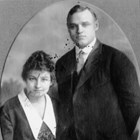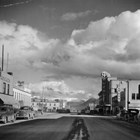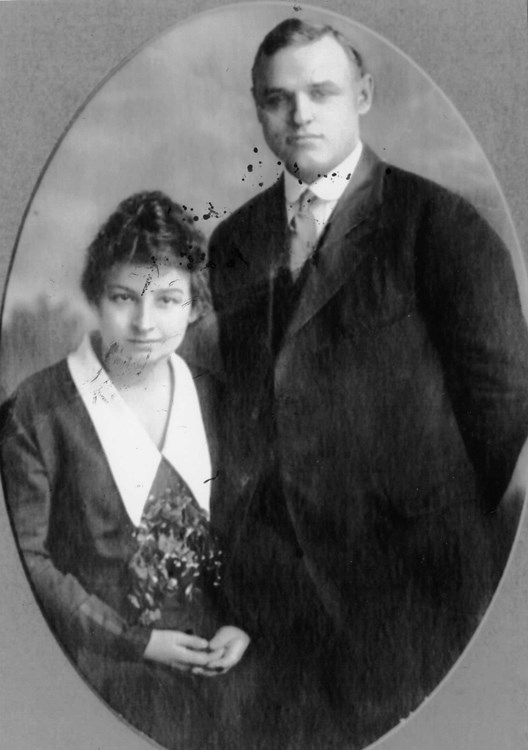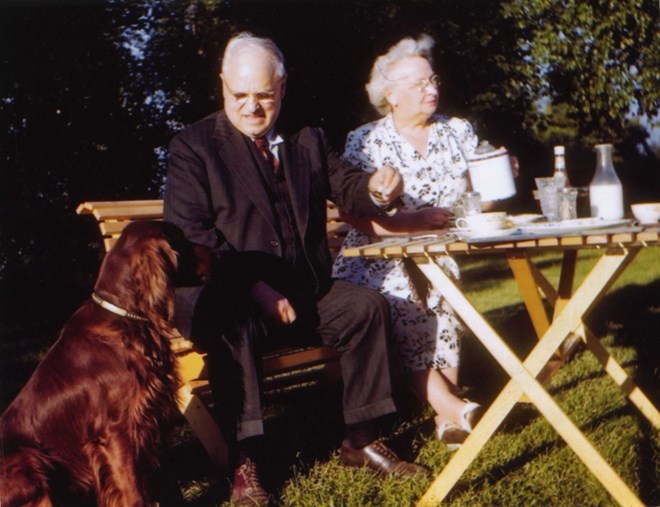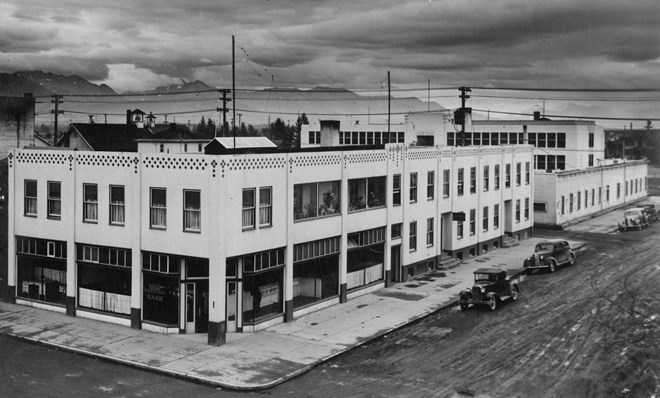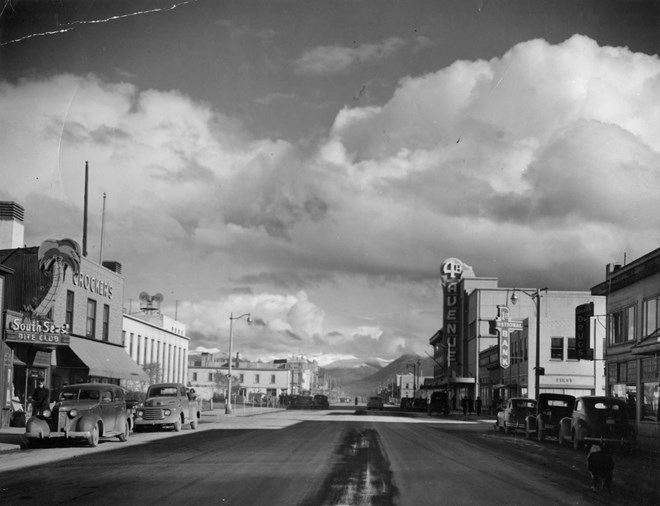Cuddy, Warren N.
1886-1951 | Banker, Attorney, and Businessman
Warren N. Cuddy guided the First National Bank of Anchorage, buying controlling interest in 1941 and becoming bank president for the next ten years. As founder and steward of a banking family that still continues today, Cuddy combined his interest in the law and keen business sense with a life-long commitment to the Anchorage community. The editor of the Anchorage Daily Times, in 1951, remarked that he “was known professionally as a practicing attorney and bank president. But he was much more than that. He used his position in business life to promote the best interests of thousands of friends and to guide the sound development of the area.”1
Early Years
Warren Ninde Cuddy, son of George Lawson Cuddy and Sarah Nanny James Cuddy, was born on October 11, 1886 in Abingdon, Hartford County, Maryland. Cuddy graduated with a B.A. from the University of Puget Sound, Tacoma, Washington, in 1911, and a year later was admitted to the Washington State Bar Association. From 1911 to 1914, he worked as a clerk at Rhodes Department Store in Tacoma.
Valdez
Cuddy first came to Alaska in 1914. He settled in Valdez where he was engaged in the grocery business. He was first employed as a grocery clerk by the Valdez Mercantile Company, a dry goods and general mercantile store. He later became the owner and manager. While in the grocery business in Valdez, he continued to study law.2
During Cuddy’s second year in Valdez, he met Lucy Hon, twenty-seven, a native of Arkansas, the principal and teacher to the town’s thirteen high school students. Following graduation from the University of Arkansas at Fayetteville in 1911, she taught in high schools in Arkansas for five years. Prior to 1916, her home was in Fort Smith, Arkansas. Warren and Lucy traveled from Valdez to her home in Arkansas in the summer of 1917 where, on August 16, they were married, and then returned to Alaska.3
From 1921 to 1928, Cuddy served as the clerk of court, U.S. District Court, Third Judicial Division, District of Alaska, at Valdez.4 The vast Third Division comprised southcentral Alaska and included a two-thousand mile stretch of the Alaska Peninsula and the Aleutian Chain. Periodically, Cuddy and other court officials within the Division traveled by steamer as a “floating court”5 to remote villages to try civil and criminal cases and handle other court matters, making justice more accessible to individuals who could not afford to travel to the court seat at Valdez.6 In 1928, Cuddy, a Republican, was appointed as U.S. district attorney for the Third Division. After Franklin D. Roosevelt was sworn in as president in 1933, Joseph W. Kehoe of Ketchikan replaced Cuddy as U.S. district attorney.7
Move to Anchorage (1933)
In 1933, Cuddy and his family moved to Anchorage and he took over the law practice of J.S. Truitt who became the attorney general for the Territory of Alaska. Cuddy was an officer with the Anchorage Light and Power Company, which provided hydroelectric power to Anchorage from the Eklutna River.
After the Alaska Rural Rehabilitation Corporation (ARRC) came into existence in 1935, Cuddy served on its board of directors which managed the Corporation. The ARRC emerged in 1936 as the primary administrative agency of the Matanuska Colony. The Matanuska Valley project was a New Deal experiment which transplanted two hundred farm families from economically depressed counties in the Midwest to Alaska to start new farms in the Matanuska Valley. The influx of farming families brought an extraordinary infusion of about $200 million into southcentral Alaska between 1935 and 1941 at the height of the Great Depression.8 A fortunate consequence of the development of the Matanuska Valley Colony was that Cuddy became interested in the fortunes of a struggling bank, the First National Bank of Anchorage.
First National Bank of Anchorage
Residing in Anchorage, Cuddy became more prominent in the banking business than in law. Cuddy began buying stock in the First National Bank of Anchorage, and acquired a major interest in it while continuing to practice law. The First National Bank of Anchorage had been established in 1922 by Winfield Ervin Sr., backed by a group of men associated with the Alaska Railroad. Located at the corner of Fourth and G Street, it was founded at a time of overexpansion in business during the Alaska Railroad construction boom of the early 1920s.9
Cuddy gradually assumed policy control of the First National Bank of Anchorage.10 In 1941, he purchased controlling interest and assumed the role of president.11 He steered the bank on a path of growth “mainly by parlaying its national certification to win government business” over its competitor, the Bank of Alaska, and to attract new customers. 12 As a national bank under the Comptroller of the Currency, the First National Bank of Anchorage had long monopolized business with the Alaska Railroad, the military, and other government agencies. First National’s membership in the Federal Deposit Insurance Corporation (FDIC) enabled it to grow much faster during the wartime boom, as federal agencies and the military did business only with government-insured banks.13 The preponderance of government employees in Anchorage (e.g., the Alaska Railroad, Civil Aeronautics Authority, and the two military bases—Elmendorf Air Force Base and Fort Richardson) led to the deposit of Treasury checks at First National. When Fort Richardson (later called Elmendorf Air Force Base) was opened, First National was granted the right to establish a branch banking facility on the base. In 1943, First National built a banking facility on Adak Island to accommodate the banking needs of U.S. Navy personnel. That same year, the bank was chosen to supply the payroll for all troops stationed in Alaska.14
Under Cuddy’s leadership, the First National Bank’s assets grew from $2.2 million in 1940 to $20.5 million in 1950. First National was by far the largest bank in southcentral Alaska, with deposits some forty percent larger than its major competitor, the Rasmuson family’s Bank of Alaska. In 1950, the Bank of Alaska joined the FDIC and became the National Bank of Alaska, to put it into a more competitive position with the First National Bank of Anchorage.15
While Warren Cuddy devoted more time to his extensive banking business, he continued to practice law with his son, Daniel “Dan” Cuddy. The family law firm, Cuddy & Cuddy, had its office on Fourth Avenue next to the bank. Warren Cuddy also served on the Territorial Board of Law Examiners.16
Later Years
Active in civic affairs, Warren Cuddy was a member of the Elks, Masons, and the Anchorage Rotary Club. When the Loussac Foundation was created in 1946, Cuddy served on the first board of directors with the Reverend R. Rolland Armstrong (pastor of First Presbyterian Church), Judge Anthony Dimond, Z.J. “Zach” Loussac, and Elmer E. Rasmuson.17 In addition, he was one of the original incorporators of Star Air Lines in 1937. After Alaska Star Airlines was created in 1942, he served as president of its board of directors until 1943.18
Warren Cuddy died in Anchorage, at age 65, on September 9, 1951 following a heart attack. Lucy Cuddy, his widow, became chairman of the board, a position she held until her death in 1982. They are both buried in the Masonic Tract of Anchorage Memorial Park Cemetery. Her son, Dan Cuddy, became president of the bank at age 30. Their oldest son, David Warren Cuddy (First Lieutenant, U.S. Army), was killed at the Battle of Anzio, Italy, during World War II.
The Alaska Rural Rehabilitation Corporation established an annual scholarship, known as the Warren N. Cuddy Memorial Scholarship, in 1955. The scholarship was awarded to a member of the graduating class of either the Palmer or Wasilla High School to attend the University of Alaska in Fairbanks.19 In 2001, the bank adopted the name First National Bank Alaska.20 Today, Cuddy continues to be remembered by a scholarship sponsored by both the ARRC and the Palmer branch of the First National Bank Alaska.
In 1951, a group of Cuddy’s friends presented a memorial of rare books and maps (Warren N. Memorial Collection) in memory of Warren Cuddy to the Anchorage City Library and established a fund for future purchases. The family of Warren Cuddy presented his collection of books to the Anchorage Public Library. From this base, the Alaska Collection at Z.J. Loussac Library grew to 25,000 volumes (as of 1996), and the First National Bank of Anchorage Employees Club continued to donate funds for new books in memory of his wife, Lucy Cuddy.21
Endnotes
- “Warren N. Cuddy [Editorial],” Anchorage Daily Times, September 10, 1951, 2.
- “Late News Bulletin; Anchorage Banker Dies,” Fairbanks Daily News-Miner, September 10, 1951, 1, http://newspapers.org (accessed August 8, 2015). His obituary was also published as "Warren Cuddy, Prominent Banker, Attorney Dies," Anchorage Daily Times, September 10, 1951, 1 and 8.
- “Wedding Bells,” [Fort Smith Times-Record?, August 16, 1917?], Lucy Cuddy, “Bits and Pieces from an Ordinary Life,” and “Lucy Cuddy Recalls Early Years,” Anchorage Times, March 27, 1976, Folder 1, Typescript Reminiscence; Lucy Cuddy Papers, 1925-1946 and 1979 (HMC-0095), Box 1; and Marriage License, Warren Ninde Cuddy and Lucy Hon, August 15, 1917, Sebastian County, Fort Smith, Arkansas, Arkansas County Marriages, 1838-1957, database, FamilySearch.org (accessed August 8, 2015).
- W.D. Cuddy, Official Register of the United States Containing a List of the Officers and Employees in the Civil, Military, and Naval Service, 1921-1925-1927, U.S., Register of Civil, Military and Naval Service, 1863-1959 [database on-line], http://ancestry.com (accessed August 8, 2015); and Evangeline Atwood and Robert N. DeArmond, compilers, Who’s Who in Alaskan Politics: A Biographical Dictionary of Alaskan Political Personalities, 1884-1974 (Portland, OR: Binford & Mort for the Alaska Historical Commission, 1977), 21.
- In 1910, the U.S. District Court at Valdez began operating a floating court by using a U.S. revenue cutter to transport judges and other court officials to geographically remote villages within the division. Typically, doctors, nurses, dentists, and social workers traveled together with the floating court to provide government services and to project government authority. Claus M-Naske, A History of the Alaska Federal District Court System, 1884-1959, and the Creation of the Alaska Court System (Anchorage: Alaska Court System, 1985), 311-334.
- “Alaska Court History,” in National Archives Microfilm Publication M1788, Indexes to Naturalization Records of the U.S. District Court for the District Territory, and State of Alaska (Third Division), 1903-1991 (Washington, DC: National Archives and Records Administration, 1996), 2-3.
- Announcement, “W.N. Cuddy announces his resignation as United States Attorney for the Third Division, Territory of Alaska and the opening of law offices at Anchorage, Alaska, for the general practice of law,” October 2, 1933, in Lucy Cuddy, “Bits and Pieces from an Ordinary Life,” Lucy Cuddy Papers, 1925-1946 and 1979 (HMC-0095), Box 1, Folder 1, Archives and Special Collections, Consortium Library, University of Alaska Anchorage, Anchorage, AK; “Our Interests at National Capital,” Fairbanks Daily News-Miner, October 2, 1933, 7, http://Newspapers.com (accessed August 8, 2015).
- Stephen Haycox, Alaska: An American Colony (Seattle: University of Washington Press, 2002), 250.
- Terrence Cole, Banking on Alaska: The Story of the National Bank of Alaska, Volume I: A History of NBA (Anchorage: First National Bank Alaska, 2002), 130-131.
- Elmer E. Rasmuson, Banking on Alaska: The Story of the National Bank of Alaska, Volume II: Elmer’s Memoirs: Anecdotes and Vignettes of My 90 Years (Anchorage: National Bank of Alaska, 2000), 273; and 1922-2002: The History of One Alaska Bank, First National Bank Alaska (Anchorage: First National Bank Alaska, 2002), 5.
- The chronological history of First National Bank Alaska, 1922-2002: The History of One Alaska Bank, First National Bank Alaska, indicates that Warren Cuddy purchased controlling interest and became president in 1941. Lucy Cuddy’s biographical sketch in the Alaska Women’s Hall of Fame uses 1941 as the date he became bank president (http://alaskawomenshalloffame.org/alumnae/pg/2). Elizabeth Tower, Anchorage: From Its Humble Origins as a Railroad Construction Camp, City History Series (Fairbanks: Epicenter Press, 1999), 193, and Rae Arno’s Anchorage Place Names: The Who and Why of Streets, Parks, and Places (Anchorage: Todd Communications, 2008), 24-25, both give 1943 as the date.
- John Strohmeyer, Historic Anchorage: An Illustrated History (San Antonio, TX: Historical Publishing Network for the Anchorage Museum Association, 2001), 25.
- Ibid., 31.
- Elmer E. Rasmuson, Banking on Alaska: The Story of the National Bank of Alaska, Volume II: Elmer’s Memoirs: Anecdotes and Vignettes of My 90 Years, 57; “Company History,” First National Bank Alaska, https://www.fnbalaska.com/about-fnba/company-history (accessed August 15, 2015); and 1922-2002: The History of One Alaska Bank, First National Bank Alaska, 6.
- Terrence Cole, Banking on Alaska: The Story of the National Bank of Alaska, Volume I: A History of NBA, 276-280.
- “Ten Budding Barristers Seek to Take Next Bar Examination,” Fairbanks Daily News-Miner, August 22, 1951, 6, Newspapers.com (accessed August 8, 2015).
- Elmer E. Rasmuson, Banking on Alaska: The Story of the National Bank of Alaska, Volume II: Elmer’s Memoirs: Anecdotes and Vignettes of My 90 Years, 304.
- The airline’s middle name was dropped in 1944, and it became Alaska Airlines. Archie Satterfield, The Alaska Airlines Story (Anchorage: Alaska Northwest Publishing Company, 1981), 62, 82, and 84.
- “Memorial Fund at University Given by Corporation,” Fairbanks Daily News-Miner, September 15, 1955, 6.
- Rae Arno, Anchorage Place Names: The Who and Why of Streets, Parks, and Places, 25.
- Warren N. Cuddy Memorial Scholarship, Alaska Rural Rehabilitation Corporationhttp://arrc.us/scholarships (accessed August 15, 2015); “Cuddy Dedication Set Sunday at City Library,” “2 Rare Books Added to Cuddy Collection,” and “41 Books, $260 Contributed to W.N. Cuddy Memorial Library,” in Lucy Cuddy, “Bits and Pieces from an Ordinary Life,” n.d. Folder 1, Lucy Cuddy Papers, 1925-1946, and 1979 (HMC-0095), Box 1, Archives and Special Collections, Consortium Library, University of Alaska Anchorage; and Jackie Musgrave, Looking Back: A Short History of Public Libraries in Anchorage (Anchorage: Municipality of Anchorage, 1996), 21.
Sources
This biographical sketch of Warren N. Cuddy is based on an essay which originally appeared in John Bagoy’s Legends & Legacies, Anchorage, 1910-1935 (Anchorage: Publications Consultants, 2001), 357-358. See also Warren N, and Lucy Cuddy file, Bagoy Family Pioneer Files (2004.11), Box 2, Atwood Resource Center, Anchorage Museum at Rasmuson Center, Anchorage, AK. Photographs courtesy of the Cuddy family. Note: revised and updated by Bruce Parham and Walter Van Horn, August 7, 2015.
Preferred citation: Bruce Parham, “Cuddy, Warren N.,” Cook Inlet Historical Society, Legends & Legacies, Anchorage, 1910-1940, http://www.alaskahistory.org.
Major support for Legends & Legacies, Anchorage, 1910-1940, provided by: Anchorage Museum at Rasmuson Center, Atwood Foundation, Cook Inlet Historical Society, and the Rasmuson Foundation. This educational resource is provided by the Cook Inlet Historical Society, a 501 (c) (3) tax-exempt association. Contact us at the Cook Inlet Historical Society, by mail at Cook Inlet Historical Society, Anchorage Museum at Rasmuson Center, 625 C Street, Anchorage, AK 99501 or through the Cook Inlet Historical Society website, www.cookinlethistory.org.
